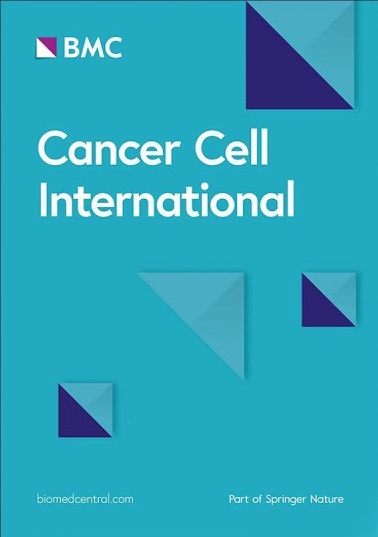Integrative analysis of aging-related genes reveals CEBPA as a novel therapeutic target in non-small cell lung cancer
IF 5.3
2区 医学
Q1 ONCOLOGY
引用次数: 0
Abstract
To explore the impact of ARGs on the prognosis of NSCLC, and its correlation with clinicopathological parameters and immune microenvironment. Preliminary research on the biological functions of CEBPA in NSCLC. Using consensus clustering analysis to identify molecular subtypes of ARGs in NSCLC patients; employing LASSO regression and multivariate Cox analysis to select 7 prognostic risk genes and construct a prognostic risk model; validating independent prognostic factors of NSCLC using forest plot analysis; analyzing immune microenvironment correlations using ESTIMATE and ssGSEA; assessing correlations between prognostic risk genes via qPCR and Western blot in NSCLC; measuring mRNA and protein expression levels of knocked down and overexpressed CEBPA in NSCLC using CCK-8 and EdU assays; evaluating the effects of knocked down and overexpressed CEBPA on cell proliferation using Transwell experiments; examining the correlation of CEBPA with T cells and B cells using mIHC analysis. Consensus clustering analysis identified three molecular subtypes, suggesting significant differential expression of these ARGs in NSCLC prognosis and clinical pathological parameters. There was significant differential expression between the two risk groups in the prognostic risk model, with P < 0.001. The risk score of the prognostic risk model was also P < 0.001. CEBPA exhibited higher mRNA and protein expression levels in NSCLC cell lines. Knockdown of CEBPA significantly reduced mRNA and protein expression levels of CEBPB, YWHAZ, ABL1, and CDK1 in H1650 and A549 cells. siRNA-mediated knockdown of CEBPA markedly inhibited proliferation, migration, and invasion of NSCLC cells, whereas overexpression of CEBPA showed the opposite trend. mIHC results indicated a significant increase in CD3 + CD4+, CD3 + CD8+, and CD20 + cell counts in the high CEBPA expression group. The risk score of the prognostic risk model can serve as an independent prognostic factor, guiding the diagnosis and treatment of NSCLC. CEBPA may serve as a potential tumor biomarker and immune target, facilitating further exploration of the biological functions and immunological relevance in NSCLC.对衰老相关基因的整合分析发现 CEBPA 是治疗非小细胞肺癌的新靶点
探讨 ARGs 对 NSCLC 预后的影响及其与临床病理参数和免疫微环境的相关性。初步研究 CEBPA 在 NSCLC 中的生物学功能。利用共识聚类分析确定 NSCLC 患者中 ARGs 的分子亚型;利用 LASSO 回归和多变量 Cox 分析选择 7 个预后风险基因并构建预后风险模型;利用森林图分析验证 NSCLC 的独立预后因素;利用 ESTIMATE 和 ssGSEA 分析免疫微环境相关性;通过 qPCR 和 Western 印迹评估 NSCLC 中预后风险基因之间的相关性;使用 CCK-8 和 EdU 检测法测量 NSCLC 中基因敲除和过表达 CEBPA 的 mRNA 和蛋白表达水平;使用 Transwell 实验评估基因敲除和过表达 CEBPA 对细胞增殖的影响;使用 mIHC 分析检测 CEBPA 与 T 细胞和 B 细胞的相关性。共识聚类分析确定了三种分子亚型,表明这些ARGs在NSCLC预后和临床病理参数中的表达存在显著差异。在预后风险模型中,两个风险组之间存在明显的表达差异,P<0.001。预后风险模型的风险评分也是P<0.001。CEBPA 在 NSCLC 细胞系中表现出较高的 mRNA 和蛋白表达水平。siRNA介导的CEBPA基因敲除明显抑制了NSCLC细胞的增殖、迁移和侵袭,而CEBPA的过表达则表现出相反的趋势。mIHC结果显示,CEBPA高表达组的CD3 + CD4+、CD3 + CD8+和CD20 +细胞数明显增加。预后风险模型的风险评分可作为一个独立的预后因素,指导 NSCLC 的诊断和治疗。CEBPA可能是一种潜在的肿瘤生物标记物和免疫靶点,有助于进一步探索其在NSCLC中的生物学功能和免疫学意义。
本文章由计算机程序翻译,如有差异,请以英文原文为准。
求助全文
约1分钟内获得全文
求助全文
来源期刊

Cancer Cell International
ONCOLOGY-
CiteScore
10.90
自引率
1.70%
发文量
360
审稿时长
1 months
期刊介绍:
Cancer Cell International publishes articles on all aspects of cancer cell biology, originating largely from, but not limited to, work using cell culture techniques.
The journal focuses on novel cancer studies reporting data from biological experiments performed on cells grown in vitro, in two- or three-dimensional systems, and/or in vivo (animal experiments). These types of experiments have provided crucial data in many fields, from cell proliferation and transformation, to epithelial-mesenchymal interaction, to apoptosis, and host immune response to tumors.
Cancer Cell International also considers articles that focus on novel technologies or novel pathways in molecular analysis and on epidemiological studies that may affect patient care, as well as articles reporting translational cancer research studies where in vitro discoveries are bridged to the clinic. As such, the journal is interested in laboratory and animal studies reporting on novel biomarkers of tumor progression and response to therapy and on their applicability to human cancers.
文献相关原料
| 公司名称 | 产品信息 | 采购帮参考价格 |
|---|
 求助内容:
求助内容: 应助结果提醒方式:
应助结果提醒方式:


